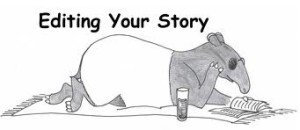In my view, story writing has three essential stages: Discovery, Writing, and Revision.
Discovery is the process by which you discover your story. Bits and pieces of character and plot swirl around in your subconscious before you put words to paper. Consider it creative energy at play rather than feeling guilty that you’re not being productive. This can be the break you need before starting the next novel. It’s time well spent to refill your creative pool and to gather ideas.
Doing a collage, watching movies, listening to music, working on a hobby, walking outdoors, or reading for pleasure are some of the ways you can stimulate your creativity. Cut out photos from magazines of celebrities who look like your characters and fill out your character development charts. Search for relevant articles to your storyline and sift through them. Thus begins your research. Often this prep time can take weeks or even a month or two. If you’re a seasoned writer, you’ll know how long you need. Be sure to factor this in when you determine your target goal of completion for your project.
When these ideas coalesce in your head and your characters begin to talk to you, you’re ready to start writing. This is when I sit down and write an entire synopsis. The synopsis acts as my writing guideline, so I always know where I’m going even if I don’t quite know how to get there. This still allows for the element of surprise. The plot may change as the story develops.
At this stage, set yourself a minimum daily quota. I have to write at least 5 pages a day or 25 pages a week. Beginning a book is the hardest task. It might take until the first third of the book for you to get to know your characters. Give yourself permission to write crap during this heated storytelling phase. Once the book is written, you can fix it. Just get those words down on paper and move forward until the draft is done.
When you finish the first round of storytelling, it’s a good idea to put your book aside so as to gain some distance from it. You’ll be better prepared for revisions with a fresh viewpoint. Use the time to plan your promo campaign, to jot down blog topic ideas, or to write reader discussion questions. When you find yourself eager to tackle the story again, move on to the next phase.
Now come the heavy revisions. This can get intense, because you need to keep a sense of the whole story in your head. You can’t stop, or you’ll lose your train of thought. But you also shouldn’t rush this process if you want to produce what editors call a “clean” copy.
When you set deadlines, be sure to allow a month or so for revisions, because you’ll need to do several read-throughs. My first round of revisions focuses on line editing. Then I’ll read through for smoothness and consistency. The final reading is to catch any remaining errors, typos, or repetitions. You can run your material through one of the online editors like Smart-Edit software or Pro Writing Aid.
I guarantee you’ll always find things to correct, but at some point you’ll be too close to the material to see straight or too sick of the project to work on it any more. Then the book is ready to submit. But don’t worry, likely you’ll have a chance to fix things again when you hear from your editor.
Send it off, clean up your desk, file away your mounds of papers. By now you’re thinking about the next book and are getting ready to start the process anew. Force yourself away from the office and take some time off. You’ll return with fresh ideas and renewed energy.
Now I have to quit procrastinating and get back to the writing stage. After being away for a week, it’s hard to get back in the groove.






